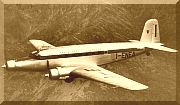1948 Keerbergen Fiat G.212 airplane crash
On 1 July 1948 the Avio Linee Italiane Fiat G.212PW “I-ELSA” was an international scheduled passenger flight from Linate Airport, Milan, Italy to Zaventem Airport, Brussels, Belgium. The airplane crashed during an emergency landing at 12:20pm local time. Eight of the twelve people on board were killed.[1][2][3]
 A Fiat G.212 of Avio Linee Italiane similar to the incident aircraft | |
| Accident | |
|---|---|
| Date | 1 July 1948 |
| Site | Keerbergen, Belgium |
| Aircraft | |
| Aircraft type | Fiat G.212PW |
| Operator | Linee Aeree Italiane |
| Registration | I-ELSA |
| Flight origin | Milano-Linate Airport, Italy |
| Destination | Brussels-Zaventem Airport, Belgium |
| Passengers | 7[1] |
| Crew | 5 |
| Fatalities | 8[1] |
| Survivors | 4[1] |
Flight and crash
editThe Avio Linee Italiane Fiat G.212PW “I-ELSA” departed in the morning of 1 July 1948 from Milano-Linate Airport, Italy for its flight to Brussel-Zaventem Airport, Belgium.[1] It was the first time a Fiat airplane was flying this destination, before that time a Doulas D.C.3 flown this route.[4] The aircraft was new and had made only 19 flight hours.[1]
At 11:50 am local time, the pilot contacted the regional control centre at Beauvais in Belgium. The weather condition was cloudy with a visibility of only 100 metres. Due to the poor visibility, the flight crew was not able to locate the airport.[1] The pilot would have tried a few times unsuccessfully to make an emergency landing.[2] Apparently they located the private airfield of Keerbergen. The aircraft circled the airfield.[1] During the landing the airplane hit treetops of the forest 500 meters from the runway, crashed and caught fire.[2][5][3]
Victims
editFour passengers and four crew members died in the crash. Two people were Belgians. The 22-year-old stewardess and three passengers were thrown out of the airplane and survived the disaster.[6][4]
Investigation
editThe conclusion of the investigation was that the pilot decided to make an emergency landing due to the bad weather conditions and the failure of both the radio communication equipment and radio navigation equipment, at another airport. To be able to land at the beginning of the runway the pilot flew a steep turn by tilting the left wing of the plane so that the roll angle put the aircraft at stall speed at low altitude.[1]
References
edit- ^ a b c d e f g h i Accident description for I-ELSA at the Aviation Safety Network. Retrieved on 2 July 2023.
- ^ a b c "Keerbergen herdenkt crash vliegtuig van 65 jaar geleden" (in Dutch). Het Nieuwsblad. 1 July 2013. Archived from the original on 14 July 2023. Retrieved 14 July 2023 – via Delpher.
- ^ a b "De Belgische Bermudadriehoek: de vele vergeten vliegtuigcrashes boven het vliegveld van Keerbergen" (in Dutch). Gazet van Antwerpen. 4 July 2022. Archived from the original on 18 August 2024. Retrieved 14 July 2023 – via Delpher.
- ^ a b "Fiat stortte neer: 8 doden". De Volkskrant (in Dutch). 2 July 1948. Archived from the original on 18 August 2024. Retrieved 14 July 2023 – via Delpher.
- ^ Frans Van Humbeek (2003). Het verdronken vliegveld van Keerbergen (in Dutch). Het Streekboek. ISBN 9789076495057 – via Delpher.
- ^ "Italiaans vliegtuig bij Brussel brandend neergestort". Nieuwsblad van het Zuiden (in Dutch). Het Nieuwsblad van het Zuiden. 2 July 1948. Archived from the original on 18 August 2024. Retrieved 14 July 2023 – via Delpher.